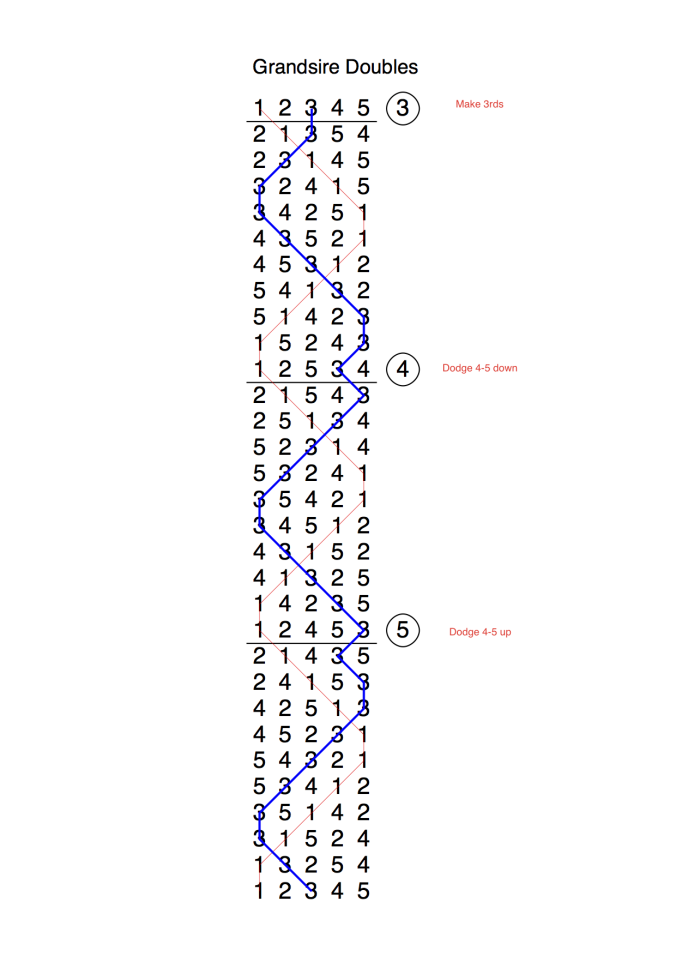17: Grandsire: Ringing a working bell.
Once you're trebling confidently to Doubles (there's no rush!) and you've hunted the 2nd to a few plain courses of Grandsire, it's time to think about ringing Grandsire Doubles on a working bell: the 3rd. The ropesight's a bit different on the 3rd. You have to watch two bells on either side of you so, before having a go at Grandsire, just ring a few leads of Plain Hunt on 5 to get used to that.
You already know a lot about Grandsire if you've got this far. Let's put that knowledge to work. We know that:
- The plain course of Grandsire Doubles is 30 rows long and consists of three leads of 10 rows each.
- The only point where it differs from Plain Hunt is at the handstroke after the treble leads. Grandsire Doubles, most of the time, is just Plain Hunt.
- The last lead of the plain course is identical to the lead of Plain Hunt on the 3rd that you've already practised.
- The third starts by making thirds and going in to the front. This is different from the way the third starts in Plain Hunt.
- To sum up: you're going to do very little that isn't just plain hunting. You're going to start differently (by making 3rds), and, after that, there are just two new things to do, called dodges. We'll look at those next. After the second of those dodges, you'll be into what should be a familiar lead of Plain Hunt.
Here's what you've been waiting patiently for: a diagram of Grandsire Doubles, with your work on 3rd shown by a nice clear 'blue line'. The treble is shown, as is customary, in red, so you can see how your work relates to what the treble is doing.

For the moment, ignore the numbers in the circles at the start of each lead. Let’s focus on what the 3rd does. There are three ‘pieces of work‘. They are shown in red on the diagram, and are listed here:
- Make 3rds (You do this immediately at the start)
- Dodge 4-5 down (You do this at the end of the first lead)
- Dodge 4-5 up (You do this at the end of the second lead)
Let’s look carefully at the dodges. A dodge is simply a step back in the opposite direction to the way you’re going. All the dodges in Grandsire happen at handstroke.
The first dodge is a 4-5 down dodge. It’s called a down dodge because you do it as you are hunting down to the front. This is what you do:
- Lie behind as normal.
- Begin hunting down (into 4ths place).
- Hold the next handstroke back up into 5ths place (this is the dodge)
- Carry on hunting down as normal.
The second dodge is a 4-5 up dodge. It’s called an up dodge because you do it as you are hunting up to the back. This is what you do:
- Hunt all the way up to 5ths place as usual.
- Instead of lying, cut the handstroke back into 4ths place (this is the dodge)
- Now hold back up (at backstroke) into 5ths place and lie behind as normal.
- Hunt down as normal.
After this second dodge, you should find yourself in a familiar lead of Plain Hunt. The bells run round at the next lead end.
Nobody expects you to remember these ‘blow by blow’ instructions for doing a dodge. They are just a description of what you do. The important thing is to match up the instructions with what the blue line shows you. If you can do that, and keep a picture of the blue line in your mind, with a bit of practice and some help from your teacher, you’ll be fine.
It’s quite easy to muddle up the 4-5 down and 4-5 up dodges. To help avoid that:
- Study them carefully, both the blue line and the description.
- Only dodge when you have seen or heard the treble leading. If the treble’s not at the front, there can’t be any dodges due, so just keep hunting.
- Remember that each dodge only lasts for one handstroke. Everything else is plain hunt. If you make a mess of a dodge, just keep hunting. Somebody will nudge you back into the correct position.
- Remember that lying in 5ths place is a backstroke followed by a handstroke, not the other way round.
- Don’t panic!
- If in doubt: keep hunting.
- Be prepared to come back and read this post again until you have taken it all in. The step from hunting to ringing a working bell is probably the hardest thing you’ll ever need to do. Once you’ve learned (as you do in Grandsire Doubles) to make places and do dodges, you’ll be well on the way to ringing any method you can think of.
Most people learn the order of the three pieces of work (3rds, 4-5 down, 4-5 up), so you should probably do that. There’s not that much to remember! In fact, all three working bells do the same work in the same order, but starting in different positions. That’s what those big numbers in circles are for. They show you that:
- The 3rd starts by making 3rds
- The 4th starts with a 4-5 down dodge
- The 5ths starts with a 4-5 up dodge
Once you can ring the 3rd to a plain course, ringing the 4th or 5th is no harder. You just start in a different place.
All the time you are ringing the 3rd, keep an eye, or an ear, or both, on the treble, and remember that until you see or hear the treble leading, all you do is Plain Hunt. As the treble leaves the front, there is just one blow of work (either make 3rds or dodge in 4-5), and then you carry on plain hunting.
You can get better at seeing and hearing the treble by watching it, or listening to it with your eyes shut, any time you’re sitting out. Just make sure that it’s a plain method that’s being rung. The treble does something different in methods like Stedman, Kent and Cambridge.
Finally, some things to look out for which should help you:
- Once you’ve lead and hunted up for the first time, you always hunt down behind the 5th. The 5th is your course bell.
- When you dodge, there is another bell dodging with you (either the 4th or the 5th). You follow that bell twice, in consecutive handstrokes for the down dodge, and in consecutive backstrokes for the up dodge.
- When you pass the treble, the next bell will always be the 2nd (because both the treble and the 2nd are plain hunting).
Have fun!



